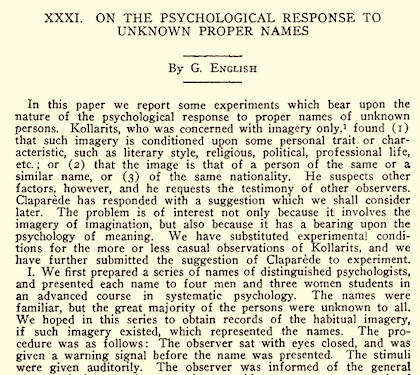Marc Abrahams's Blog, page 247
October 5, 2016
Podcast 84: What sort of person is named Rupzóiyat?
Unpronounceable names — Chérin; Póisher; Kilom; Koikert; Vázal; Dáwfisp; Zóque; Spren; Dáwthô; Rupzóiyat; Blag; Lísrix; Thaspkûwhin; Kîrd’faumish; Génras; Tháchô; Brob. Zóitû; Kóldak; Múrbix; Chermtgáwkonv; Bóppum; and a bunch of others — and what other people make of those unpronounceable names, enliven this week’s Improbable Research podcast.
SUBSCRIBE on Play.it, iTunes, or Spotify to get a new episode every week, free.
This week, Marc Abrahams discusses medical reports about toothbrushes that mysteriously found their way into people’s stomachs and other deeply secret places. Boston University psychology professor emerita Jean Berko Gleason wrestles with all those names, giving dramatic readings and opinions:
Rupzóiyat and other such names: “On the psychological response to unknown proper names,” G. English, American Journal of Psychology, vol. 27, 1916. 430-434.
The mysterious John Schedler or the shadowy Bruce Petschek perhaps did the sound engineering this week.
The Improbable Research podcast is all about research that makes people LAUGH, then THINK — real research, about anything and everything, from everywhere —research that may be good or bad, important or trivial, valuable or worthless. CBS distributes it, on the CBS Play.it web site, and on iTunes and Spotify).

October 4, 2016
How good are mathematicians at telling a joke?
You may have wondered how good mathematicians are at telling a joke.
Here’s mathematician Henry Segerman telling a topology joke — the one about the coffee cup and the donut:
Here’s another mathematician, Ian Agol, telling the same joke (filmed by Scientific American.)
Here’s Jim Fowler making the joke wordlessly:
Three anonymous, shy mathematicians make the joke wordlessly (but for a cough):
And here, probably destined to be most famous of all, is the presentation in Stockholm of the parable of the cinnamon bun, the bagel and the pretzel:
BONUS (distantly related): A presentation of the möbius bagel-cutting principle, with added lox, by Eugenia Cheng:

A man, his oobleck, and his hydraulic press
FYFD alerts us to this video of a well-accented man, his oobleck, and his hydraulic press:
The man is from the Hydraulic Press Channel.
FYFD adds some charmed explanation of the goings on:
Oobleck is probably the Internet’s favorite non-Newtonian fluid. People vibrate it, run across it,shoot it, drop it, and even use it to fix potholes. But how does oobleck hold up to a hydraulic press? Fortunately, that’s been covered, too. Oobleck is a mixture of cornstarch and water, and it’s a bit unusual in that it is a shear-thickening material. That means that the faster you try to deform it, the more it will resist that deformation. Knowing this makes the above video’s results make more sense.…
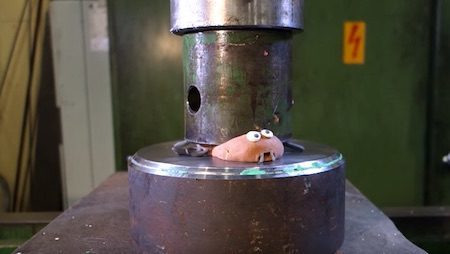
The Hydraulic Press Channel presses out other videos, of which this next one, titled “Can you fold paper more than 7 times with hydraulic press?”, is perhaps the most famous:

Keith Wampler joins Luxuriant Flowing Hair Club for Scientists (LFHCfS)
Keith Wampler has joined the Luxuriant Flowing Hair Club for Scientists (LFHCfS). He says, not tersely:
My hair while also beautifully blond, grows insanely fast. I have have grown it out to about this length three times in the last 15 years and the most recent growth is only about three years old. I have never spent more than $5 on shampoo and I only get it trimmed once a year. My five year old’s friends all want to touch my “Elsa” hair when I drop her off at kindergarten. I did a Ph.D. with Dick Schrock at MIT from 2005-2010 during which time he was co-awarded the 2005 Nobel Prize in Chemistry for the development of the olefin metathesis method in organic synthesis. After the prize we made a new generation of catalysts that I am now using to literally save the world. After MIT, I decided that I wanted to be a process chemist and take these catalysts which were nothing more than a lab oddity and use them on the metric ton scale and I did that. My first start-up is/was called Elevance Renewable Sciences and there we used my catalysts and some related, more industrially relevant catalysts from one of the other awardees of that Nobel prize to transform cooking oils into chemicals. From there I some how convinced a company in Santa Monica, California to move me out here so I could start smoking weed and going to the beach, which has been pretty awesome.
Keith Wampler, Ph.D, LFHCfS
Senior Scientist
Provivi, Inc.
Santa Monica, California, USA


Like a fish needs an aeroplane
A whatever needs a whatever like a fish needs an aeroplane. Watch this video, and discuss:
BONUS: There are other such phrases, generally involving bicycles. Some involve, women, some involve men, some involve cows.

October 3, 2016
Determinants of Phantom Phone Sensations (PPSs)
 Do you own a mobile phone? Do you sometimes think there’s a call when actually there isn’t? If so, that might well be a Phantom Phone Sensation (PPS). Leading, perhaps, to the question :’What are the determinants of phantom phone sensations?’ These (fairly) ubiquitous phenomena have been formally investigated by a research team at the Media and Communication dept. at the University of Duisburg-Essen, Germany. Their study – said to be the first comprehensive overview of factors that influence the likelihood of experiencing phantom phone sensations – found that 83.5% (of those asked) had experienced them. And, further :-
Do you own a mobile phone? Do you sometimes think there’s a call when actually there isn’t? If so, that might well be a Phantom Phone Sensation (PPS). Leading, perhaps, to the question :’What are the determinants of phantom phone sensations?’ These (fairly) ubiquitous phenomena have been formally investigated by a research team at the Media and Communication dept. at the University of Duisburg-Essen, Germany. Their study – said to be the first comprehensive overview of factors that influence the likelihood of experiencing phantom phone sensations – found that 83.5% (of those asked) had experienced them. And, further :-
“The results indicate that it might predominantly be the current situation which a person is in that promotes the experience of phantom phone sensations. In line with theoretical knowledge on the importance of social situations as influencing factors in everyday life, our results show that social factors are prevalent also for false perceptions such as phantom phone sensations.”
See: The phantom in my pocket: Determinants of phantom phone sensations in: Mobile Media & Communication, vol. 3 no. 3 pp. 293-316.

October 2, 2016
Bird jousting in a wind tunnel: How to avoid collisions
Birds, not carrying weapons of any sort, jousted by special arrangement of three scientists in Australia.
Details are in the study: “Strategies for Pre-Emptive Mid-Air Collision Avoidance in Budgerigars,” Ingo Schiffner, Tristan Perez, and Mandyam V. Srinivasan, PLoS ONE, 11(9): e0162435. The authors, at the University of Queensland, Australia, report:
Trajectories of birds flying towards each other in a tunnel were recorded using high speed video cameras. Analysis and modelling of the data suggest two simple strategies for collision avoidance: (a) each bird veers to its right and (b) each bird changes its altitude relative to the other bird according to a preset preference. Both strategies suggest simple rules by which collisions can be avoided in head-on encounters by two agents…
Two birds were released from the opposite ends of the tunnel, at an initial separation of either 5 meters or 10 meters from each other…. Over the course of 4 days, we tested a total of 7 pairs, consisting of 10 individual birds, and recorded a total of 102 flights. No collisions were observed in the entire study.
(Thanks to Nicki Rapoli for bringing this to our attention.)
This study cites a study by 2003 Ig Nobel Interdisciplinary Research Prize co-winner Stefano “Chickens Prefer Beautiful Humans” Ghirlanda.
The new study does not cite the collision-avoidance research that led to the awarding of the 2005 Ig Nobel Peace Prize to Claire Rind and Peter Simmons of Newcastle University, in the U.K., for electrically monitoring the activity of a brain cell in a locust while that locust was watching selected highlights from the movie “Star Wars.”
BONUS (not much related): A seemingly inhuman reading of a John Lennon poem about a Budgerigar:

October 1, 2016
Strawberry scrotum, the doctors’ delight
Doctors are, sometimes, fascinated by scrotums and by strawberries. Studying scrotal symmetry – or its lack – yielded an Ig Nobel prize in 2002. As discussed on this blog previously, the 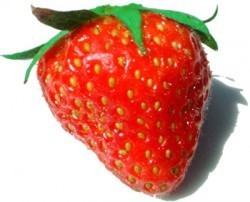 strawberry is used extensively as an analogy in medical practice. The scrotum and strawberry have a lot in common, for example, their distinctive skins.
strawberry is used extensively as an analogy in medical practice. The scrotum and strawberry have a lot in common, for example, their distinctive skins.
The scrotum is essentially a bag that holds the testes away from the body to keep them cool so that sperm can form properly. There is a rare condition that isn’t life threatening of the skin’s scrotum where it looks like a strawberry’s skin. Unsurprisingly it is named Strawberry scrotum. Here is how it develops.
BONUS: Other genital entities related to the strawberry in the scientific medical literature.
Casale AJ, Menashe DS. Massive strawberry hemangioma of the male genitalia. J Urol. 1989.
Carrasco L, Izquierdo MJ, Fariña MC, Martín L, Moreno C, Requena L. Strawberry glans penis: a rare manifestation of angiokeratomas involving the glans penis. Br J Dermatol. 2000.

September 30, 2016
A kitchenly scholar’s visit (with son) to the Ig Nobel ceremony
Robert Harington and his son survived being in the audience at the 2016 Ig Nobel Prize ceremony. (Harington is Associate Executive Director, Publishing at the American Mathematical Society.) He wrote about the experience, for The Scholarly Kitchen. He says:
Let’s first set the stage. Each year, there is a theme, and this year it was “Time”. Of course this led to the some 1100 strong audience to shout “woohoo” at every mention of the word “time”, or “second” etc. My son got to exercise his vocal cords. The whole thing kicked off with paper airplane throwing and you can see how this works in the video. I have to say that the tantalizingly efficient guardian of paper airplane throwing, Nicole Sharp (creator of FYFD, the world’s most popular web site about fluid dynamics) was remarkable. In addition to the prizes themselves, given out by real Nobel Prizewinners — this years crop included Dudley Herschbach (Nobel Prize for chemistry 1986), Eric Maskin (Nobel prize for Economics 2007) and Rich Roberts (Nobel Prize for Physiology/Medicine 1993), there were mini-lectures in which a leading expert in a field gave a 24-second talk on their topic, followed by a 7-word summary. There was an opera, games, and live scientific experiments.
The prizewinners of course take center stage. This years winners included some fabulously funny and odd research.
The Biology prize was shared between Charles Foster of the University of Oxford and Thomas Thwaites. Charles Foster lived in the wild as if he were an animal – at different times a badger, a deer, a fox and a bird. Thomas Thwaites told us that he had enough of being a human and created prosthetic limbs that allowed him to move like a goat and spend time living among goats in the Alps. The Medicine prize was…
See for yourself. Here’s video of the entire ceremony:
This photo, taken by Mike Benveniste, shows the new Ig Nobel Prize winners, the Nobel laureates, the cast of the new opera, and other Ignitaries gathered at ceremony’s end for a pointless photo opportunity:
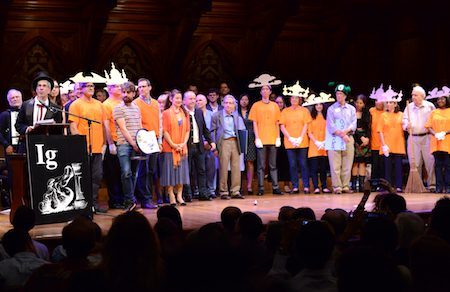
Lavish details will be included in this year’s special Ig Nobel issue (vol. 22, no. 6, November/December 2016) of the Annals of Improbable Research.

About our “Ig Glorious” ticket holders
The audiences who come to Sanders Theater to watch the Ig Nobel Prize Ceremony include scientists, science enthusiasts, and people who have no connection to science. Some of them come individually, some of them come in groups (self-organized Official Audience Delegations). And then there are the very special “Ig Glorious” ticket holders.
“Ig Glorious” tickets are a way for a few of our audience members to be especially (and financially) supportive of the Igs. They sit in excellent locations and enjoy access to the “Ig Glorious Liaison”, a glorious person who assists them in small, glorious ways throughout the evening. Ig Glorious ticket holders receive a few other perks as well, such as a gift bag that holds: (1) an Ig Nobel poster signed by at least one of the new winners; and (2) other inconsequential items.
And immediately after the ceremony officially concludes, they can pose for a photo on the Ig Nobel stage with one of the Human Spotlights! Here’s what that looks like:

One of our 2016 “Ig Glorious” ticket holders, onstage with a Human Spotlight. The Human Spotlight is on the right, holding a non-human spotlight aimed at an Ig Glorious person.
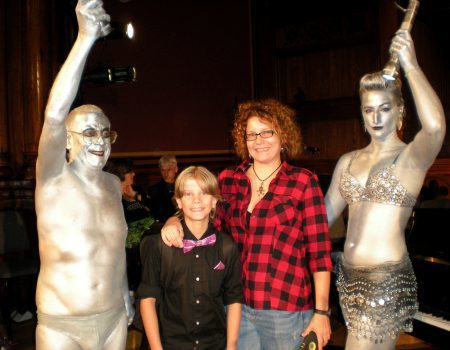
Two of our 2015 “Ig Glorious” ticket holders, onstage with two Human Spotlights. The Human Spotlights are on the far left and the far right. The one on the left is Jim Bredt, who invented the concept of a Human Spotlight and who also is one of the inventors of 3D-printing. The one on the right is Katrina Rosenberg.
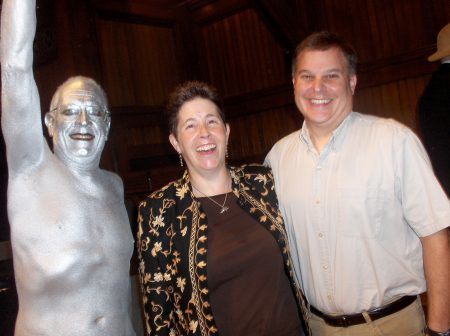
Two of our 2016 “Ig Glorious” ticket holders, onstage with a Human Spotlight. The Human Spotlight is the one who, in this photograph, has no visible clothing.

Marc Abrahams's Blog
- Marc Abrahams's profile
- 14 followers


